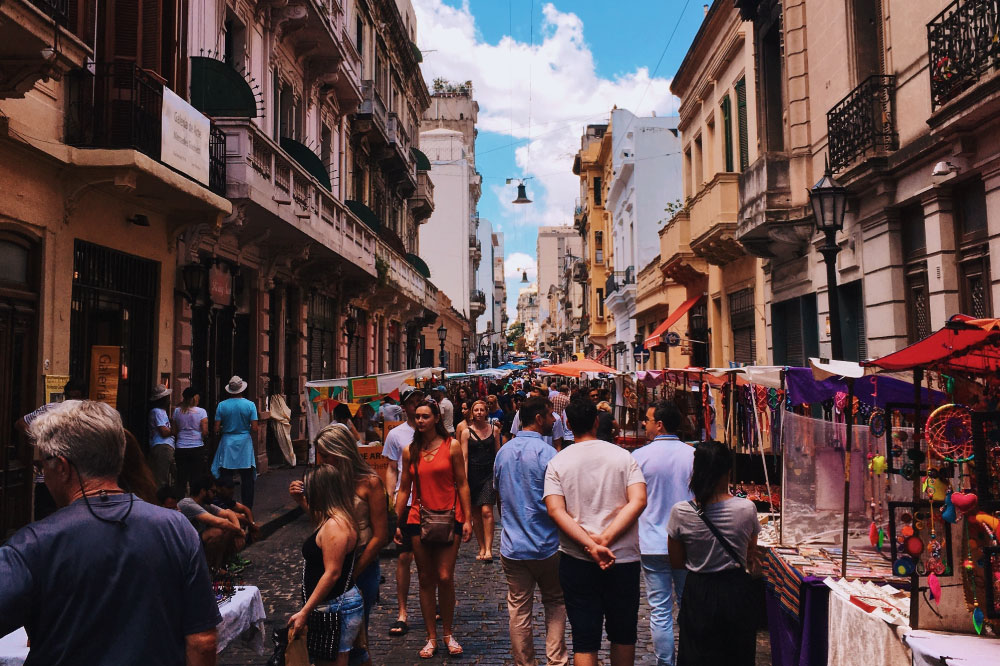What Your Travel Business Needs To Know About Group Travel Tours (Post-Pandemic)
What does the world of group travel look like in 2022?
Well, considering there has been a 122% increase in group booking rates since 2020 and a 50% increase since 2021 - it is fair to say that travel is coming back in full force.
Before the pandemic, it was only too common to see busloads of tourists on planned group trips traveling through popular tourist destinations. These days, this image has changed drastically. The tourists are still there, but the large busses and group tours don’t necessarily look the same as they used to.
In this guide, we’ll take a deep dive into the state of group travel tours right now, and how things look post-pandemic.
Download FREE eBook
The Ultimate Guide To Scaling Your Tour Operator Business
A 150-page guide that covers everything from establishing a winning travel brand to delivering a market-leading service
Why Group Travel?
All-inclusive group tours have always been a popular option for travelers. This may be attributed to the fact that they offer a level of convenience to the traveler, as “all-inclusive” generally means all meals, and flights and itineraries are planned and mapped out for an allocated travel group (for a fee of course).
This makes group travel a popular choice, especially for people who might otherwise find organizing a trip or traveling without a guide overwhelming. Group travel tours are often also designed for travelers looking for specific experiences - like solo female travelers or LGBTQ+ group travel tours.
There are many reasons why group travel makes sense, but there are also many concerns around it as we emerge from the pandemic. With group travel being totally stopped in its tracks two years ago, it is now reemerging in a slightly different way.
10 Group Travel Tour Facts Your Travel Business Should Know
1. People Are Ready To Make Travel Bookings Once Again
While group trips may look slightly different because of the severity of the pandemic, the good news is they’re still an attractive option for travelers.
Travelers of all demographics are more comfortable traveling now than they were a year ago. This may be attributed to the rollout of Covid vaccines, the implementation of safety protocols, or, just a lust to get back to a sense of travel normalcy.
At the start of 2022, more than half of US adults said that they were planning to travel for leisure this year. Travelers who traveled frequently before the pandemic are also most likely to be planning another trip soon.
This means that group travel is rapidly bouncing back to where it once was, with the same people finding a renewed interest in travel. The only difference is what group tours will look like and how big they will be.

2. Group Travel Is Starting Small
Most travel companies have restarted their group experiences with small tours. For example, Intrepid Travel cut off all of its North American group tours during the pandemic. They only started offering small group retreat-style tours within Europe. These were very limited to match the consumer interest in group tours.
This could be good news for retreat leaders, as wellness tourism and retreats also seem to be on the rise. It is predicted that the wellness tourism market will reach $919bn in 2022, which makes it representative of 18% of all global tourism.
The same report shows that over a billion wellness trips are planned to take place around the globe.
Even though travel has returned to a semi-normal state, the popularity of small group tours and retreat-style travel remains. This could be a major area for travel companies to focus on in the years ahead.
3. There’s An Uptake In Private Group Travel
Just as smaller retreat-style group travel has become more popular, so has the demand for private, small-group travel.
For example, the tour operator SOTC Travel released a Holiday Readiness Travel Report showing 63% of respondents wanted to travel solo, 3% wanted to travel in small groups, and 12% were happy to travel in groups with less than 35 people. This demand resulted in the company focusing more on private small-group tours for groups of families and friends.

Their tours follow all relevant Covid protocols and have pre-planned itineraries. The difference is that every element, from chauffeur-driven transport to experiences, remains private.
This kind of group travel may become more popular as time goes on. Although, it also comes at a greater price compared to traditional group tours. This may result in a different clientele that was initially targeted.
4. Expect To Focus On Safe Travel
Since the pandemic, many group travel operators have focused on promoting the fact that they are a Safe Travels provider, as recognized by the World Traveler and Tourism Council. This means the travel companies follow specific globally-recommended Covid guidelines. Even with travel opening up around the globe again, these kinds of trust badges remain important.
Another way to earn trust is by staying close to expert travel recommendations. Many travel companies are only offering group tours to countries cleared for travel based on the World Health Organization, Centers for Disease Control and Prevention, and U.S. Department of State travel advice.
It’s also highly recommended to develop a travel safety charter or promise to share it with your clients. It should show the measures your company is taking to ensure a safe and memorable journey for everyone.
Many travel companies have introduced a stress-free travel experience commitment. This is their version of a travel safety charter, which ensures that all relevant safety requirements and protocols are met to help group tours travel with more confidence.
Travel regulations may be easing up, but travelers still want to know that they are in safe hands. This is especially true for group travel. This shows how important it is for travel companies to be transparent about their health and safety procedures, and to take travel safety measures seriously.

5. Increase In Domestic Offerings
Since the initial tightening of travel restrictions, there has been far greater interest and focus on domestic travel.
Travel companies have seen a 28% increase in domestic travel interest since the pandemic, which caused them to introduce 19 new domestic itineraries. Spurring this development were complicated international travel quarantine requirements and the difficulties that come with catching flights in a post-pandemic world.
This focus on domestic travel has also brought increased interest in driving holidays. Due to quarantines and travel restrictions, many travelers are rethinking flying holidays and are replacing them with shorter driving holidays instead.
Shorter curated group tours that don’t involve flying have become increasingly popular. An example of this is the increasing demand for road trip-style travel itineraries launched by bespoke travel companies.
In fact, in the US, domestic travel and tourism spending is forecasted to reach over $1.1 trillion in 2022. This is 11.3% greater than pre-pandemic levels, which reveals just how much more popular domestic travel has become.
6. Travelers Want to Get Away From the Crowds
More tour operators and travel companies are focusing on offering group tours to remote destinations, like Alaska. This is a strategic way to offer group travel without making travelers feel as though they are part of a large group.
As a tour operator, now may be the time to explore more offbeat destinations and craft itineraries focused more on escaping the crowds.

7. Group Tours Scheduled for Less Busy Times Of the Year
On this note of escaping the crowds, group travel has also become more prevalent at less busy times of the year. With many complications involved in traveling and flying, tourists have looked more towards traveling at times with fewer crowds.
An added benefit is that traveling ‘out of season’ may also be cheaper for groups.
Group travel operators should consider increasing the number of trips offered in the quieter months of the year to accommodate this growing trend.
8. Sustainable Travel Is At The Heart Of Many Booking Decisions
Sustainable, conscious travel is certainly the way forward in 2022. In fact, over 53% of people want to travel more sustainably in the future. Luckily, there are many actions you can take to ensure sustainability is a core focus in your business and client offering.
A place to start is the accommodation you offer - 73% of travelers would rather choose providers that have implemented sustainability practices. Not only this, but these travelers are willing to pay up to 75% more per night to stay in an eco-friendly place.
Group tour operators should also consider looking at ways to reduce the carbon footprint of their trips and promote more sustainability in their itineraries.
You can achieve this by using more environmentally-friendly accommodation options, focusing on more eco-friendly transport solutions (like trains and electric vehicles), and promoting carbon offsetting in your tours, among other actions.

And while travelers become more aware of the environmental impact that travel has on communities, 76% of them would like to reconnect with nature. This means you can look into nature experiences and outdoor travel as part of your packages.
Supporting local businesses is another major factor in sustainability. For example, instead of purchasing regular tourist souvenirs and shopping at big businesses, travelers are seeking out more localized experiences. A study revealed that 42% of travelers focus on shopping at local small businesses during their travels.
As a tour operator, you can drive revenue and increase upselling opportunities for your group tours by promoting more local experiences and shopping opportunities. In doing this, try to highlight how the businesses you partner with are making a positive impact on the local economy.
9. Travelers Are Willing To Spend More Money
According to a 2022 travel report, 15% of Americans said they will be upgrading their rooms and flights when they travel, 3% of travelers will splurge more on their trip to make it extra special, and younger travelers are more likely to go big on their next trip (travelers aged 18 to 34 years).
For group travel operators, this signals a shift toward more expensive, exclusive, and luxurious travel. Travelers don’t just want to experience the same tours that existed before Covid. Now, they are happier to pay a premium for a greater experience.

10. The Largest Group Tour Market Is Changing
China is the world’s largest market for outbound travel. According to the same report, Chinese tourists are also the world's biggest spenders. Within this enormous tourism market, 55% of Chinese travelers preferred group travel before the pandemic.
Today, 68% of Chinese tourists find it impossible to book group tours and are opting for self-guided travel instead. The rest are looking more toward small and private group tours, as opposed to the large bus group tours that were so popular before the pandemic and travel restrictions.
This is another example of group travel turning towards a smaller, more private approach.
Conclusion
Watching the tourism industry come alive after a surreal two-year pandemic is refreshing to witness. The positive impact this is having on economies (and businesses) is heartwarming, to say the least.
But, this new horizon looks different for nearly every aspect of travel, including group travel. Travelers are definitely ready to see the world again, but they’re doing it with more intention and care. Above all, they’re seeking quality experiences where they can connect with people and places they meet on their journey.
Incorporating the facts from the points listed above into your travel business strategy will assist you in meeting the demands of travelers in our new age of travel (post-pandemic).
New resources, straight to your inbox
We’re committed to your privacy. WeTravel uses the information you provide to us to contact you about our relevant content, products, and services. You may unsubscribe at any time.




